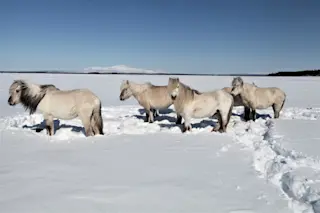As the Arctic continues to thaw because of global climate change, more and more researchers are looking for ways to stop the irreversible melt. In a paper out Tuesday in Scientific Reports, one research team suggests a new way to keep things cooler: Recruit reindeer.
The Arctic’s hooved residents compact snow as they graze, packing it into a denser, thinner layer. The researchers estimate that thinning the snow layer above the frozen soil, called permafrost, could cut how much it warms by about 44 percent. It’s because the thinner snow layer brings the cold Arctic air that much closer to the soil below.
Permafrost is supposed to be, as its name suggests, permanently frozen. Roughly 8.8 million square miles of the Northern Hemisphere are covered by this layer of ice-bound soil and dirt. But hotter temperatures on Earth are changing the nature of this frozen ground. In unfrozen soil, bacteria ...














